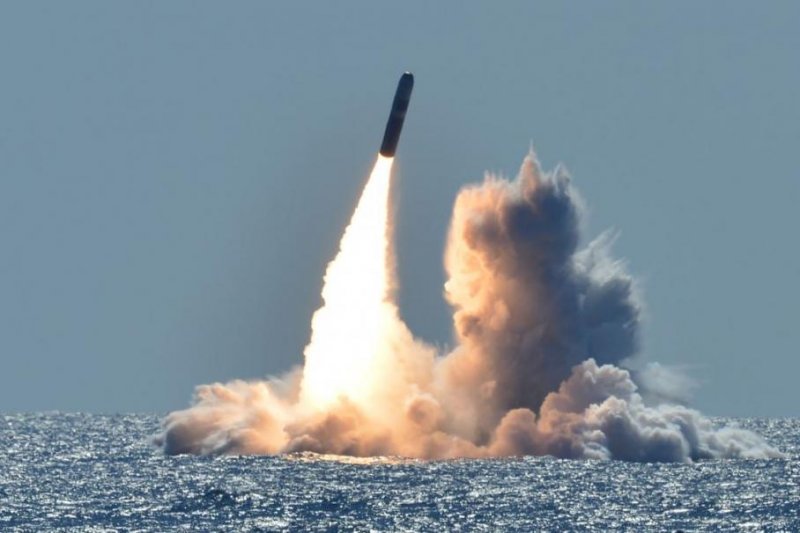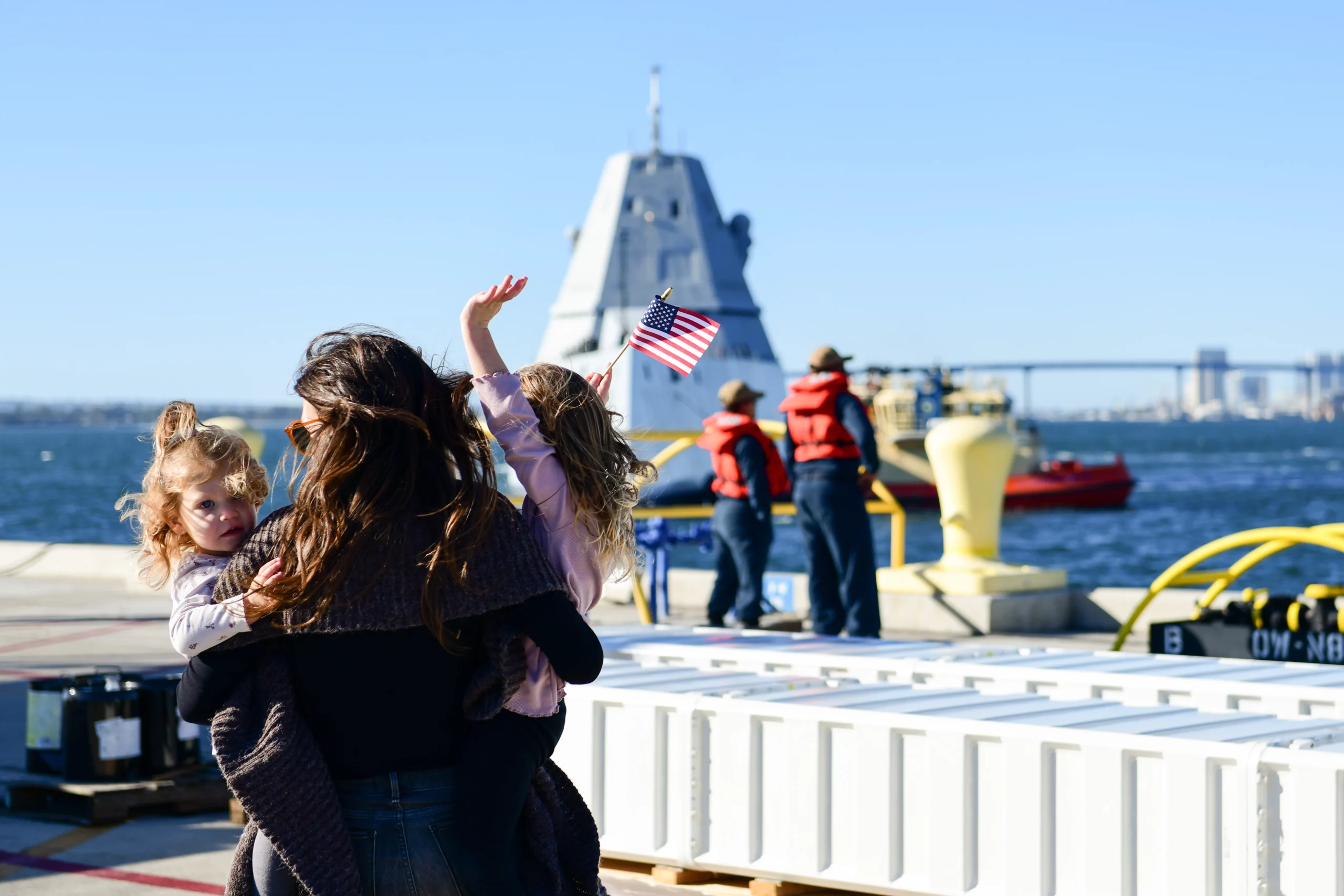Navy plans to mount hypersonic missiles on Zumwalt stealthy mega-destroyers
- By Hope Seck
Share This Article

The Navy’s trio of DDG-1000 Zumwalt mega-destroyers have been ships without a main weapon – or a clear mission – for years. But that may be about the change as the service gives them a leading role in its plans to integrate hypersonic weapons with the fleet.
In documents accompanying the Defense Department’s fiscal 2024 budget request, released in March, the Navy announced plans to buy eight Conventional Prompt Strike (CPS) missiles to field onboard the Zumwalt. Next year’s budget calls for $341 million to buy the hypersonic rounds and another $901.1 million for research and development. Ultimately, the service wants to spend $3.6 billion – enough to buy about two Arleigh-Burke class destroyers or a quarter of an aircraft carrier – over the next five years to purchase 64 of the missiles, which it plans to mount on Virginia-class submarines as well.

The Navy plans to move fast. Its newly released plans call for the deployment of the first CPS missiles on the USS Zumwalt, the flagship of the class, in fiscal 2025. The third and last ship of the class, DDG-1002 USS Lyndon B. Johnson, which remains under construction, will be constructed and commissioned with the missiles already integrated.
For the Zumwalt program, which has endured a series of high-profile setbacks, the addition of hypersonic missiles could be the start of a redemption story.
Armed with an array of weapons, DDG-1000 will provide the Joint Force Commander with precision strike and volume fires, a budget justification document states. “Designed with sustainable payload, multi-spectral stealth and optimal manning, DDG 1000 will take the fight to the enemy with unprecedented striking power […] This naval surface hypersonic strike capability will be able to conduct independent forward deployed operations and prosecute deep-inland, time-critical, soft and medium-hardened targets in a contested environment. The CPS capability, combined with the low observable characteristics of the ZUMWALT platform, creates a uniquely lethal and survivable naval surface platform.”
Related: Navy taps Lockheed, Raytheon to develop new hypersonic HALO missile

As Sandboxx News reported earlier this year, major defense contractor Lockheed Martin Corp. has received a $2 billion contract from the Navy to deliver the CPS missiles, which are also being purchased by the Army. A Hypersonic Glide Vehicle weapon that employs a rocket booster to reach speeds in excess of Mach 5 – and potentially much, much faster – HGVs can travel on a flight path much closer to Earth than conventional ballistic missiles. The missiles’ expected range, 1,700 miles, is about half that of an intercontinental ballistic missile (ICBM). But the magic of hypersonic weapons is in their movement: they can maneuver unpredictably, changing course to hit a target or avoid a threat. Thus, they’re extremely difficult to intercept and pose a much greater threat to the enemy.
Last year, Sandboxx News reported on the promise hypersonic tech holds for the Zumwalt class. Built with sloping geometric hulls designed to appear on radar as much smaller commercial fishing boats, thus throwing off any enemy trackers, the ships were originally envisioned as a larger class. But amid cost overruns and delays, the Navy ultimately opted to buy just three. The class received another major blow in 2016 when the purchase of ammunition for its special 155mm Advanced Gun System main weapon was canceled due to the eye-watering ammunition cost of $800,000 per round. The first two ships of the class, the Zumwalt and the Michael Monsoor, were commissioned in 2016 and 2019 respectively. The Zumwalt completed its very first deployment, to the Pacific, last year.
Related: The Air Force’s plans for an F-15EX training base are in flux as Pacific focus intensifies

But Jerry Hendrix, an analyst at the Sagamore Institute and retired Navy captain who spoke with Sandboxx News last year, said hypersonics make the Zumwalt “the answer to a question we didn’t know we had.” The advanced communication capabilities aboard the ship, berthing for 150 and stealthy profile make the ship formidable for insertion in regions with area-denial defenses, he said. All this could put the long-sidelined Zumwalts at the forefront of the future near-peer fight in the Pacific for which the Pentagon is now preparing.
According to budget documents, the Navy CPS program is now working to design a “common all up round” including a 34.5-inch two-stage booster and a thermal protection system. The Army and Navy will use the same missile body design, and the Army will be responsible for production, with plans to start fielding systems by the end of this fiscal year.

“The Navy will design, develop, and produce the missile booster, as well as integrate the missile booster with [the common hypersonic glide body],” documents state. “Each service will use the common hypersonic missile while developing individual weapon control systems and launchers tailored for launch from sea or land.”
Navy officials say installation of the missiles onboard the ships will happen during previously scheduled and upcoming Building Yard Modernization Periods, but doubts still remain about how the service plans to complete testing and development to meet its ambitious timeline.
A recently released document from the Defense Department’s Director of Operational Testing and Evaluation (DOT&E) shows that the Navy has four joint flight campaign testing evolutions planned over the next fiscal year “to develop and demonstrate a hypersonic, cold-gas launched missile system prototype capability” but noted that the first test, which took place last June, resulted in an “anomaly.” While that failure prevented some of the planned data collection, DOT&E stated that the Navy had determined what went wrong with the test and was getting ready for the second planned test, to take place at Cape Canaveral, Florida.
Navy leaders revealed last month that the second test, originally set for March 5, had to be scrubbed during a battery failure. The third test, according to DOT&E, will launch from the Army’s prototype transporter-erector-launcher “and provide a demonstration of launch capability for the Army’s [long-range hypersonic] Dark Eagle program.”

DOT&E cited concerns that the Navy may not be as far along in its testing plans as it should be at this point.
“The Navy has yet to identify test conditions and associated test resources that will be evaluated across the three CPS phases to adequately assess lethality and operational effectiveness in the threat-contested environment,” its evaluation document states. “The Navy is considering inclusion of the threat-contested environment in Phase 1 testing, but has yet to commit due to developmental test requirements. These data are necessary to validate and use model and simulation for operational testing, and delays in data collection could increase operational test cost in later CPS phases.”
With just two ships available for testing, finding the right windows to complete all necessary evaluations could be a significant challenge for the Navy. The Zumwalt class may have a new opportunity for redemption, but it’s definitely not out of the woods yet.
Read more from Sandboxx News
- Navy lingo decoded: Terms every Sailor should know
- Was the Air Force’s hypersonic ARRW missile killed by a rush to save face?
- In the world of SMGs, these 2 weapons have always had a unique relationship
- Researchers want to prevent injuries in Soldiers before they happen
- Find your reason to join the military
Related Posts
Sandboxx News Merch
-

‘AirPower’ Classic Hoodie
$46.00 – $48.00 Select options This product has multiple variants. The options may be chosen on the product page -

‘Sandboxx News’ Trucker Cap
$27.00 Select options This product has multiple variants. The options may be chosen on the product page -

F-35 ‘Lightning’ Framed Poster
$45.00 – $111.00 Select options This product has multiple variants. The options may be chosen on the product page
Hope Seck
Hope Hodge Seck is an award-winning investigative and enterprise reporter who has been covering military issues since 2009. She is the former managing editor for Military.com.
Related to: Breaking News, Gear & Tech, Military Affairs

How the military bounced back from the recruiting crisis
Sandboxx News
-

‘Sandboxx News’ Trucker Cap
$27.00 Select options This product has multiple variants. The options may be chosen on the product page -

‘AirPower’ Classic Hoodie
$46.00 – $48.00 Select options This product has multiple variants. The options may be chosen on the product page -

‘AirPower’ Golf Rope Hat
$31.00 Select options This product has multiple variants. The options may be chosen on the product page -

‘Sandboxx News’ Dad Hat
$27.00 Select options This product has multiple variants. The options may be chosen on the product page
